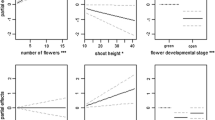Abstract
Hylema sp. 5 females oviposit on the undersides of sepals of developing buds of both Ipomopsis aggregata and Polemonium foliosissimum. Eggs deposited on the latter are significantly more likely to be fully protected by the sepal than are eggs deposited on the former. Unexposed eggs have a significantly greater likelihood of successfully developing to the larval stage than do exposed eggs. The difference in frequency of egg exposure on the two plant species can be attributed to differences in sepal morphology: I. aggregata sepals are significantly narrower than those of P. foliosissimum. The hypothesis that females preferentially oviposit on larger flowers was unconfirmed by a manipulative choice experiment. Plants differing in the size of their flowers were potted together and presented to Hylemya in arrays in the field. Flowers of the larger-flowered pair were no more likely to be oviposited on than flowers of the smaller-flowered pair. However, there were significant negative correlations between the corolla length and the percentage of flowers laid on per day at each of two sites. There was also a significant positive correlation between the corolla width and the percentage of flowers laid on at one site. Thus females appear to be using some measure of flower morphology, or a correlated trait, in making oviposition decisions. The degree to which Hylemya is making suboptimal choices between host plant species is discussed and requires further examination.
Similar content being viewed by others
REFERENCES
Bell, W. J. (1990). Searching behavior patterns in insects. Annu. Rev. Entomol. 35: 447–467.
Brody, A. K. (1992a). Oviposition choices by a pre-dispersal seed predator (Hylemya sp.). I. Correspondence with hummingbird pollinators, and the role of plant size, density and floral morphology. Oecologia 91: 56–62.
Brody, A. K. (1992b). Oviposition choices by a pre-dispersal seed predator (Hylemya sp.). II. A positive association between female choice and fruit set. Oecologia 91: 63–67.
Brody, A. K., and Waser, N. M. (1995). Oviposition patterns and larval success of a predispersal seed predator attacking two confamilial host plants. Oikos 74: 447–452.
Browne, L. B. (1993) Physiologically induced changes in resource-oriented behavior. Annu. Rev. Entomol. 38: 1–25.
Burstein, M., and Wool, D. (1993). Gall aphids do not select optimal galling sites (Smythurodes betae; Pemphigidae). Ecol. Entomol. 18: 155–164.
Campbell, D. R. (1991). Effects of floral traits on sequential components of fitness in Ipomopsis aggregata. Am. Nat. 137: 713–737.
Courtney, S. P., and Kibota, T. T. (1990). Mother doesn't know best: Selection of hosts by ovipositing insects. In Bernays, E. A. (ed.), Insect-Plant Interactions, Vol. 2, CRC Press, Boca Raton, FL, pp. 161–188.
Courtney, S. P., Chen, G. K., and Gardner, A. (1989). A general model for individual host selection. Oikos 55: 55–65.
Fretwell, S. D., and Lucas, H. L., Jr. (1969). On territorial behavior and other factors influencing habitat distribution in birds. I. Theoretical development. Acta Biotheor. 19: 16–36.
Karban, R., and Courtney, S. P. (1987). Intraspecific host plant choice: Lack of correspondence for Streptanthus totuosus (Cruciferae) and Euchole hyantis (Lepidoptera: Pieridae). Oikos 68: 158–166.
Larsson, S., Glynn, C., and Hogland, S. (1995). High oviposition rate of Dasineura marginemtorquens on Salix viminalis genotypes unsuitable for offspring survival. Entomol. Exp. Appl. 77: 263–270.
Mitchell, R. (1994). Effects of floral traits, pollinator visitation, and plant size on Ipomopsis aggregata fruit production. Am. Nat. 143: 870–889.
Papaj, D. R., and Rausher, M. D. (1983). Individual variation in host location by phytophagous insects. In Ahmad, S. (ed.), Herbivorous Insects: Host-Seeking Behavior and Mechanisms, Academic Press, New York, pp. 77–124.
Singer, M. C. (1986). The definition and measurement of oviposition preference. In Miller, J., and Miller, T. A. Plant-Insect Interactions, (eds.), Springer, New York, pp. 65–94.
Singer, M. C., Vasco, D., Parmesan, C., Thomas, C. D., and Ng, D. (1992). Distinguishing between “preference” and “motivation” in food choice: An example from insect oviposition. Anim. Behav. 44: 463–471.
Odendall, F. J. (1989). Mature egg number influences the behavior of female Battus philenor butterflies. J. Insect Behav. 2: 15–25.
Valladares, G., and Lawton, J. H. (1991) Host-plant selection in the holly leaf-miner: does mother know best? J. Anim. Ecol. 60: 227–240.
Wiklund, C. (1981). Generalist versus specialist oviposition behavior in Papilio machaon (Lepidoptera) and the hierarchy of oviposition preferences. Oikos 36: 163–170.
Zimmerman, M. (1979a). An Analysis of the Reproductive Strategies of Polemonium in Colorado, Ph.D. dissertation, Washington University, St. Louis, MO.
Zimmerman, M. (1979b). Oviposition behavior and the existence of an oviposition-deterring pheromone in Hylemya. Environ. Entomol. 8: 277–279.
Zimmerman, M. (1980a). Reproduction in Polemonium: Competition for pollinators. Ecology 61: 497–501.
Zimmerman, M. (1980b). Reproduction in Polemonium: Pre-dispersal seed predation. Ecology 61: 502–506.
Zimmerman, M. (1980c). Selective deposition of an oviposition-deterring pheromone by Hylemya. Environ. Entomol. 11: 321–324.
Zimmerman, M. (1982). Facultative release of an oviposition-deterring pheromone by Hylemya. Environ. Entomol. 11: 519–522.
Zimmerman, M., Cibula, D. A., and Schulte, B. (1984). Oviposition behavior of Hylemya (Delia) sp. (Diptera: Anthomyiidae): Suboptimal host plant choice? Environ. Entomol. 13: 696–700.
Author information
Authors and Affiliations
Rights and permissions
About this article
Cite this article
Zimmerman, M., Brody, A.K. Choices and Consequences of Oviposition by Hylemya (Delia) Sp. (Diptera: Anthomyiidae). Journal of Insect Behavior 11, 371–381 (1998). https://doi.org/10.1023/A:1020902714225
Issue Date:
DOI: https://doi.org/10.1023/A:1020902714225




